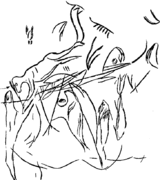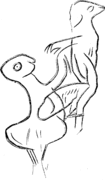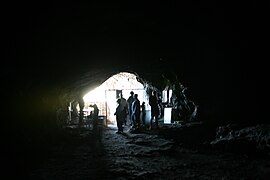Cueva de los Casares
The Cueva de los Casares is a cave with archaeological , paleontological and paleoanthropological remains, especially prehistoric rock art . It is located on the banks of the Rio Linares in Riba de Saelices in the Alto Tajo Natural Park (Parque natural del Alto Tajo) in the central province of Guadalajara , in Spain , 1162 meters above sea level. The cave and its pictures are hardly known outside of Spain.
References to the cave date from the first half of the 19th century, but no reference is made to the images discovered by the brothers Rufo and Claudio Ramírez until 1933. There are around 200 carvings from the Middle Paleolithic in the cave. There are engravings of animals such as wolverines that are hardly represented in other places. The cave is famous for a number of engravings that are believed to represent reproduction. These include one of the three depictions of copulation known from the Paleolithic, as well as those of pregnancy, childbirth and family life. The discovery was of great significance that it was studied by Francisco Layna Serrano (1893–1971), doctor and historian of the Guadalajara Province.
In 1932, the archaeologist Juan Cabré (1882–1947), accompanied by his daughter Maria Cabré, author of numerous field and photographic works on the pictures, began to explore the cave, which in 1934 made it a national monument. At the same time, renowned European archaeologists such as Henri Breuil (1877–1961) and Hugo Obermaier (1877–1946) were invited to research who had different views on the age of the engravings. Juan Cabré dated the engravings to the Aurignacien and Solutréen , 30,000 to 25,000 BC. Other authors think they are a little younger. The discovery is all the more important as this type of engraving was found in the interior of the peninsula only in the Cueva de la Hoz and Casares, 14 km away. The outbreak of the Spanish Civil War prevented all of Juan Cabré's studies.
- Cueva de los Casares
During the war, and due to the minor importance local residents gave the cave and the engravings, many were damaged, painted and signed. This wasn't the first time the engravings had suffered. There is a watchtower (Torre de Los Casares) above the cave. The Arab soldiers were the first to leave their mark here.
literature
- Andres Acosta González: (2008). Agrupación de Amigos de la Cueva de los Casares y del Arte Paleolítico. Ateneo de Madrid, Edition Los grabados de la Cueva de los Casares (Riba de Saelices, Guadalajara) AACHE Ediciones. ISBN 978-84-96885-68-4
Web links
Coordinates: 40 ° 57 ′ 27 " N , 2 ° 17 ′ 27.2" W.





